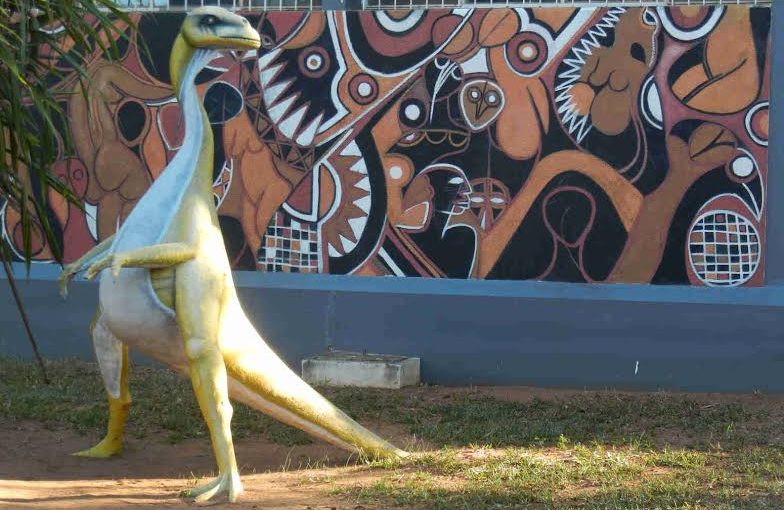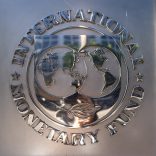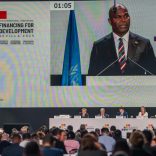Mozambique faces 'silent and destructive adversary' in illegal fishing - FAO
Mozambican recovery: All fingers point to 2018 – By Levy Sergio Mutemba

The private sector should be the main contributor to the Mozambican economy, while the Government will remain highly constrained in terms of public spending. (Photo: ECA International - A file photo of the Natural History Museum, in Maputo, where a dinosaur is sen against a Malangatana mural)
The release today by Standard Bank of its African Markets Update confirms what most recent researches say about the Mozambican economy. Namely, that it is rapidly regaining momentum after a decline of more than 4% in GDP last year.
In 2018, already, Mozambique may grow at a pace close to its pre-crisis levels, thanks to foreign direct investments in the extractive sector and the ongoing efforts by Mozambican authorities to restore macroeconomic stability – and credibility.
“This has prompted us to increase our 2018 GDP forecast to 5.7% year-on-year (y/y) from 4.4%”, explain Standard Bank’s economists. As a reminder, real GDP growth in 2015 was 6.6%. The South African-based bank also revised up its forecast for 2017 to 4.1% y/y versus an initial forecast of 3.8%, citing the absence of military tension, an improved outlook for agriculture and expectations of a substantial increase in coal production, together with the proximity of a final investment decision for ENI’s floating LNG project.
The African Markets Update outlined the importance of the private sector’s contribution to the Mozambican expected recovery, albeit limited to the primary activities, as inflation recedes and interest rates decrease. Whereas the Government tries to restructure the USD 2 billion publicly guaranteed external commercial loans linked to the issuance of debt by Ematum, Proindicus and Mozambique Asset Management, supressing the probability of any increase in public spending.
Standard Bank does not expect the Government to meet its budget targets for 2017, explaining that the slow recovery in economic activity is likely to result in lower fiscal revenues, expected at 20.8% of GDP, from a budget figure of around 23.2%. “This is likely to restrain overall expenditure. From a target of 31.1% of GDP, expenditure is forecast at 24.3%, with the cut most likely to occur in capital expenditure”, details the financial services institutions.
Present in 18 African countries, Standard Bank adds that such forecasts reflect lower external support and the need to limit the increase in domestic borrowing, which has exerted upward pressure on interest rates. At the end of 2016, the cost of capital, as measured by the 1-year rate, was indeed at 28.8%, about four times as high as in 2015. It is expected to lower this year to an average of 17.2% before further contracting to about 10% in 2018. (Rates of the same maturity were 7.6% in 2015 and 3.12% in 2012, as a reminder).
External debt is also a sharp constraint on external borrowing, as it has reached close to 95% of GDP last year versus 64% the previous year and 40% in 2014. Standard Bank also underscores the fact that the delivery to the Attorney General on 12 May of the Kroll audit report on the debts of Ematum, Proindicus and Mozambique Asset Management has increased expectations that, once made public, the report may assist the current negotiation process to restructure the publically guaranteed loans (currently in default).
“Bringing the overall debt to a sustainable path and achieving an agreement with the International Monetary Fund to restore funded assistance may also result in donors increasing aid to Mozambique”, insists the bank. “We don’t expect much progress before the full publication of the report and the announcement of accountability measures.”
Earlier last week, the African Economic Outlook (AEO), jointly published by the OECD, the African Bank and the United Nation Development Program, also insisted on fiscal management as a fundamental factor of macro stability and growth in Mozambique. “In the short term, the country faces a liquidity crisis to balance its external accounts and finance its fiscal deficits”, says the report.
“A credible fiscal tightening stance is crucial to ensure debt sustainability, hinging on the restructuring of its commercial debt.” However, large inflows of foreign direct investment since 2000 have enabled aluminium, coal and gas to constitute the country’s “industrial backbone”, with the natural gas sub-sector poised to become the main industrial cluster. “These are mostly export-oriented industries, however, with limited value addition”, concludes the AEO.
By Levy Sergio Mutemba













Leave a Reply
Be the First to Comment!
You must be logged in to post a comment.
You must be logged in to post a comment.